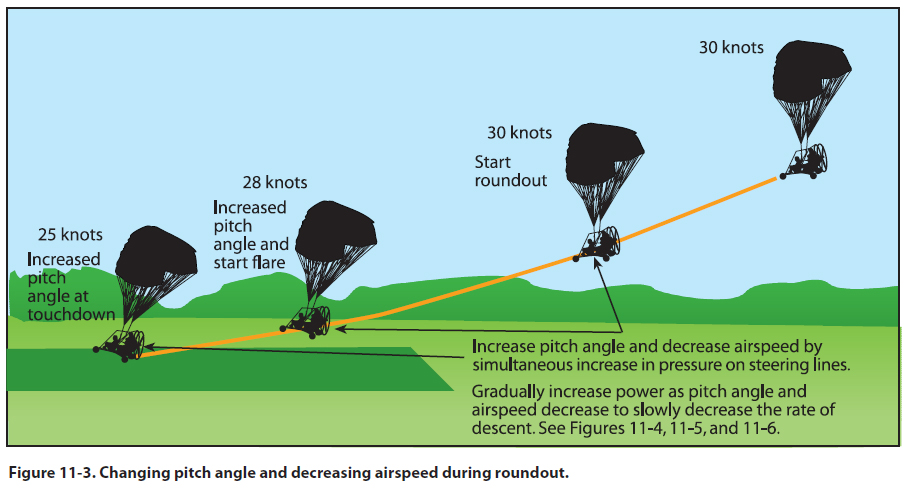|
Chapter 11 — Approaches and Landings
Estimating Height and Movement
During the approach, roundout, and touchdown, vision
is of prime importance. To provide a wide scope
of vision and to foster good judgment of height
and movement, your head should assume a natural,
straight-ahead position. Your visual focus should not
be fixed on any one side or any one spot ahead of the
powered parachute, but should be changing slowly
from a point just over the powered parachute’s nosewheel
to the desired touchdown zone and back again,
while maintaining a deliberate awareness of distance
from either side of the runway within your peripheral
field of vision. Accurate estimation of distance
is, besides being a matter of practice, dependent upon
how clearly objects are seen; it requires that vision be
focused properly for the important objects to stand out
as clearly as possible.
Speed blurs objects at close range. For example, consider
the view from an automobile moving at high
speed. Nearby objects seem to merge together in a
blur, while objects farther away stand out clearly. The
driver subconsciously focuses the eyes sufficiently far
ahead of the automobile to see objects distinctly. In
the same way, the distance at which the powered parachute
pilot’s vision is focused is normally adjusted
automatically.
If you attempt to focus on a reference that is too close
or look directly down, the reference will become
blurred, and the reaction will be either too abrupt or
too late. In this case, your tendency will be to overcontrol, round out high, and make drop-in landings.
When you focus too far ahead, accuracy in judging
the closeness of the ground is lost and the consequent
reaction will be too slow since there will not appear
to be a necessity for action. This will result in flying
into the ground without flaring.
Roundout
The powered roundout is a slow, smooth transition
from a normal approach descent rate to a landing descent
rate, gradually rounding out the flightpath to
one that is parallel with, and within a very few inches
above the runway. When the powered parachute is in
a normal descent, within what appears to be 10 to 20
feet above the ground, the powered roundout should
be started. Once started, it should be a continuous process
until the powered parachute touches down on the
ground.
As the powered parachute reaches a height above
the ground where a timely change can be made into
the proper landing descent, power should be gradually
applied to slowly decrease the rate of descent.
[Figure 11-3]

The rate at which the roundout is executed depends
on the powered parachute’s height above the ground
and the rate of descent. A roundout started excessively
high must be executed more slowly than one from a
lower height to allow the powered parachute to descend
to the ground. The rate of rounding out must
also be proportionate to the rate of closure with the ground. When the powered parachute appears to be
descending very slowly, no increase in power settings
is called for.
Visual cues are important in rounding out at the proper
altitude and maintaining the wheels a few inches
above the surface until eventual touchdown. Visual
cues are primarily dependent on the angle at which
your central vision intersects the ground (or runway)
ahead and slightly to the side. Proper depth perception
is a factor in a successful flare, but the visual cues used
most are those related to changes in runway or terrain
perspective and to changes in the size of familiar
objects near the landing area such as fences, bushes,
trees, hangars, and even sod or runway texture. You
should direct central vision at a shallow downward
angle of from 10° to 15° toward the runway as the
roundout is initiated.
Maintaining the same viewing angle causes the point
of visual interception with the runway to move progressively
rearward toward you as the powered parachute
loses altitude. This is an important visual cue
in assessing the rate of altitude loss. Conversely, forward
movement of the visual interception point will
indicate an increase in altitude, and would mean that
power was increased too rapidly, resulting in floating.
In most powered parachutes, the front wheel can easily
be seen and can be used as an indicator of how far
the main wheels are above the runway.
In some cases, it may be necessary to advance the
throttle slightly to prevent an excessive rate of sink which would result in a hard, drop-in type landing.
You should keep one hand on the throttle throughout
the approach and landing, in case a sudden and unexpected
hazardous situation requires an immediate
application of power.
|

